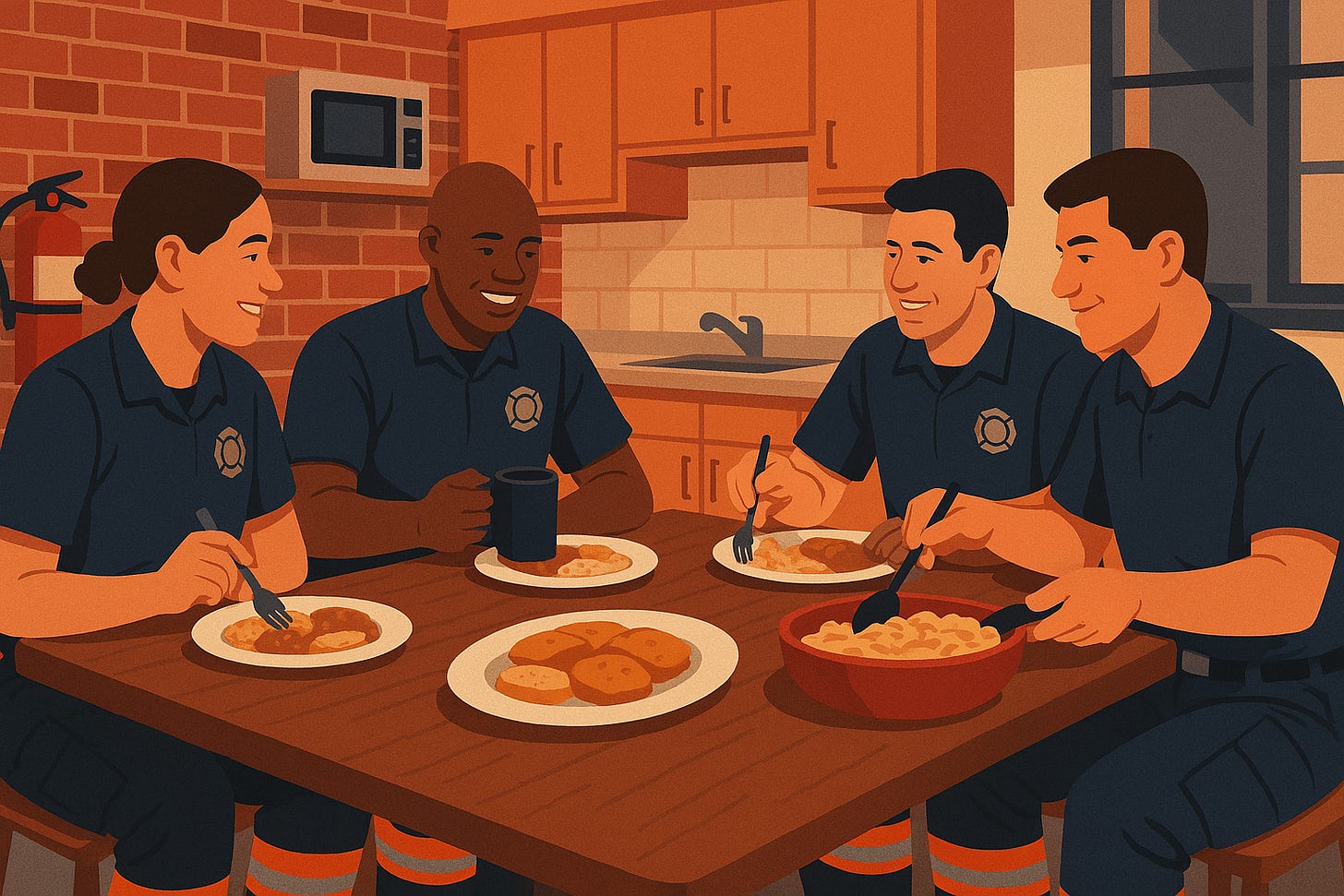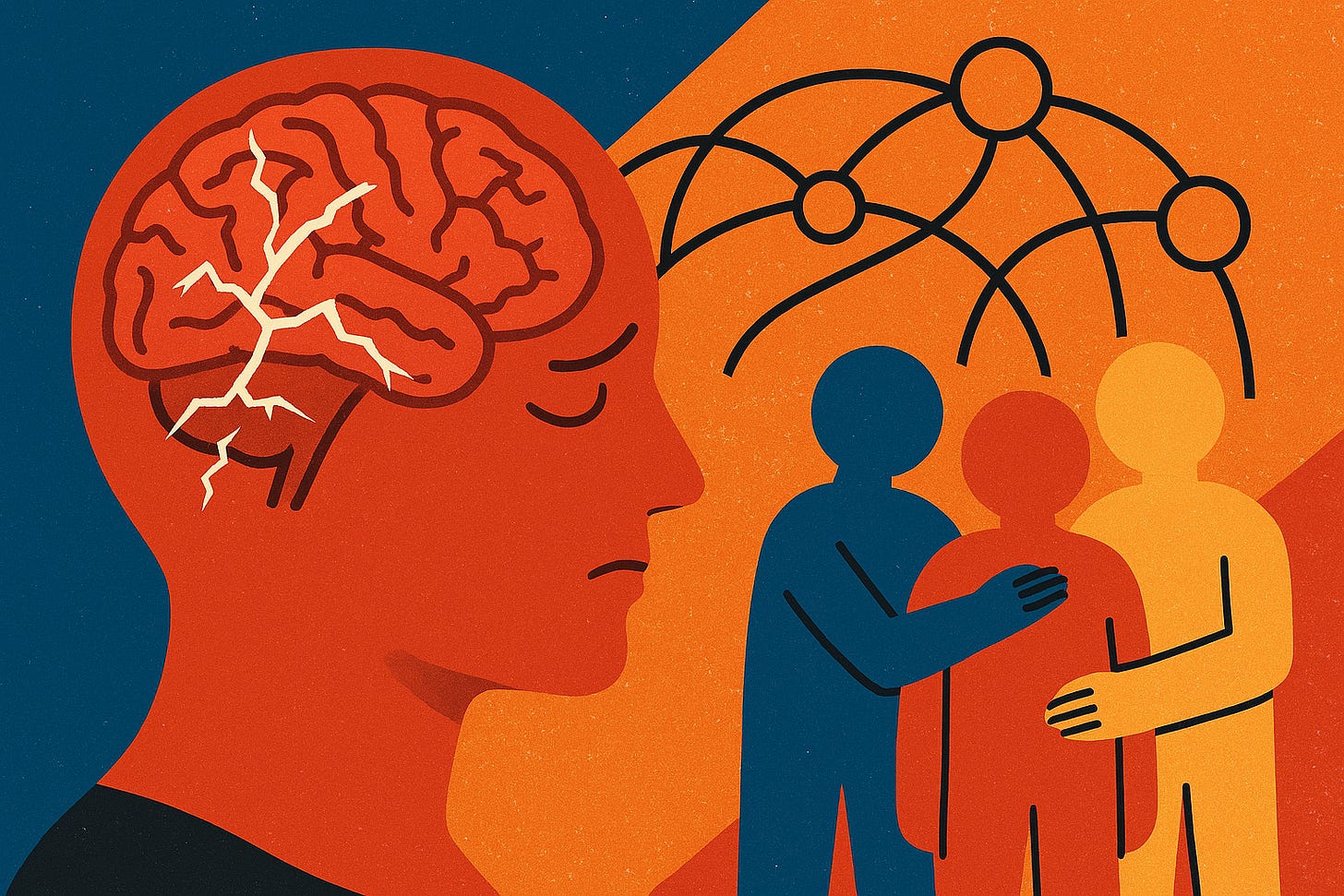Connection is Medicine, Part 2
Relationships Are Medicine: How Connection Protects the Brain, Body, and Soul
Last time, in part 1 of this series, we looked at loneliness as a health risk — the silent epidemic hiding in plain sight. Today, we’ll explore the other side of the equation: how connection repairs what isolation damages.
The Health Equivalent of Armor
In firefighting, we wear turnout gear to help guard against heat and toxins. In life, relationships are our turnout gear.
The longest ongoing study of human health, the Harvard Study of Adult Development, has tracked generations of participants for more than 85 years. Its most surprising finding isn’t about cholesterol or blood pressure or genetics, it’s this: the quality of your relationships in your mid-life is one of the strongest predictors of health and happiness for the rest of your life. People who reported being most satisfied in their relationships at age 50 were the healthiest at age 80 — more so than people with “perfect” lab numbers.
This isn’t wishful thinking; it’s biochemistry. Strong social bonds regulate stress hormones, soften inflammation, and keep our nervous systems from staying stuck in a high‑alert state. Connection literally stabilizes the rhythms that keep our hearts beating and our immune systems alert.
This theme carries across dozens of studies. A massive review by psychologist Julianne Holt-Lunstad and colleagues, pooling data from over 300,000 participants worldwide, found that people with stronger social connections had about a 50% greater chance of survival over time compared to their more isolated peers. That’s as strong as the protective effects of quitting smoking or maintaining a healthy weight.
So when we make time for a friend or share a meal with our crew, we’re not just “being social.” We’re practicing preventive medicine.
Quality Beats Quantity
None of this means you need a stadium of friends or a massive online following. One or two close, trusted relationships can do far more for your health than a hundred casual acquaintances. Sharing your struggles and joys and letting someone else really see you triggers powerful biological responses — boosting oxytocin levels, lowering stress hormones, and calming inflammation in ways that protect the heart and the brain.
The best predictor of long‑term health isn’t the number of people we know but whether we have someone we can count on when things go bad. It’s that sense of belonging that quiets the body’s stress accelerators and gives the mind space to recover.
The moments that heal can look ordinary: a shared ride home after shift, a daily check‑in text from your partner, or sitting quietly with a friend who simply listens. Those small choices keep the physiological cascade of loneliness from ever gaining momentum.
But if connection is medicine, chronic loneliness is a slow‑acting poison — one that often builds up unnoticed.
A 2023 study from the University of Michigan tracked more than 9,000 adults over two decades. Instead of measuring loneliness once, researchers looked at how often participants felt lonely across an eight‑year window, then tracked their health and survival for another 15 years.
Their findings were stunning: people who experienced loneliness repeatedly, year after year, were 16 percent more likely to die earlier than those who rarely felt lonely. Occasional loneliness isn’t the concern; it’s loneliness that comes back, piles up, and becomes normal that shortens health span.
That’s why consistent, meaningful contact acts like routine maintenance for the heart and brain. It prevents loneliness from “stacking” the way plaque stacks in arteries.
The Counterexample: Ed
Ed, the 90‑something client I introduced in Part 1, could have fit that high‑risk profile. He lost his wife. He lives alone. Statistically, he should have been vulnerable to the kind of loneliness that the Michigan study warns about.
But Ed refuses to live disconnected. His daughters visit or call daily. Neighbors check in. Our weekly training sessions double as good conversation. Those small, intentional ties have created a network that keeps moments of solitude from becoming years of loneliness. That difference may be why, instead of fading, he’s still thriving.
In research terms, Ed has successfully interrupted “cumulative loneliness.” In human terms, he’s proof that steady connection can extend both health span and life span.
Think of connection not as an occasional treat but as a biological requirement. We hydrate and eat well to feed the body; we connect to feed the systems that hold the body together.
Simple but consistent habits make the difference:
Schedule social time the way you schedule workouts or meals.
Check on your people. Don’t assume they’re fine because they say they are.
Show up, even when you don’t know what to say. Presence outperforms eloquence every time.
For firefighters and EMTs, that might mean grabbing dinner with the crew instead of eating in your vehicle. For families, it could be a standing Sunday call or weekly meal. The goal isn’t perfection; it’s pattern.
Recent breakthroughs in neurobiology show that social connection helps the brain recalibrate after trauma. Supportive relationships activate the same neural networks that process reward and safety. That’s why people who feel supported bounce back faster after loss, illness, or critical‑incident stress.
It’s also why isolation after trauma is so dangerous. When we withdraw, our physiology actually loses access to the very systems that heal us.
The message, whether for firefighters, families, or anyone who’s been through a tough season, is simple: don’t face the rebuild alone.
Looking Ahead
The evidence you’ve seen so far has focused mostly on individuals — people like Ed, or like you and me, living out the effects of connection or disconnection.
But loneliness isn’t just a personal struggle; it’s a global one. It shows up in cities, small towns, and entire nations. And systems from public policy to community design can either fuel it or fight it.
In Part 3, we’ll widen our view to look at what the world’s newest research and the World Health Organization are saying about loneliness on a planetary scale, and what practical steps communities can take to build connection into the way we live.
Coming next week: Connection Is Medicine, Part 3: Building Connection into the Culture.





Appreciate this series very much.